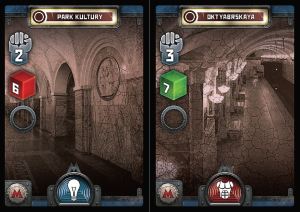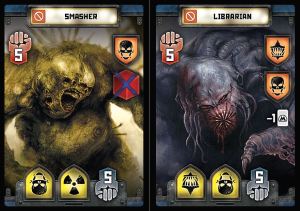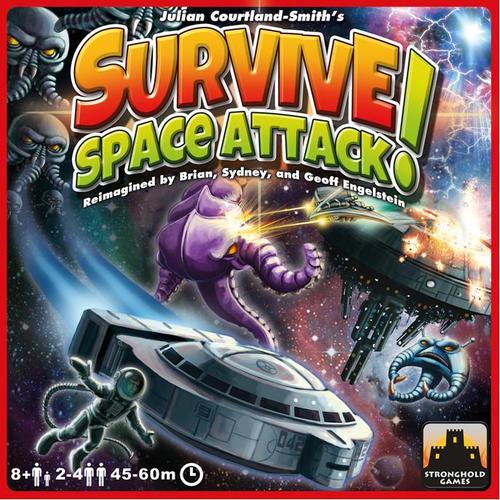It’s stayed in my collection for a long time - the whole “watch your friends/opponents be eaten by sea monsters” vibe makes it a great closer game at the end of the evening. And while I have played the newest version of the game (Survive: Escape From Atlantis), it wasn’t different enough for me to justify buying the new edition and ditching my colorful box full of plastic.
Allow me to chase a rabbit for a moment: the Stronghold Games edition of Survive: Escape From Atlantis is the best version of the game in terms of rules & playability. The Waddington’s version has two different rule sets that contradict each other - and they both lose the variable points element from PB Survive!. Stephen Buoncore managed to combine the various versions into a cohesive and very playable whole.
Yet with all that love, I’m afraid my plastic figures are about to gather dust - because Survive: Space Attack takes everything I enjoy about the game system… and makes it better. In the words of Nigel Tufnel, “It goes to 11.”
How to Turn Survive! Up To 11 in Seven Easy Steps
Step 1: Change the map
The island of Atlantis was, according to all previous versions of Survive!, a big honkin’ hexagon-shaped mountain. Survive: Space Attack starts by changing the basic shape of the doomed edifice to an elongated sort-of rectangle with tendrils.
Another aspect of changing the map is changing the way boats (OK, escape pods) are placed. No longer are they docked at specific geometric locations on the board - instead, players are each given two pods to place once all of the crew have taken up positions on the space station.
Step 1.1: Make the map double-sided
More importantly, the mapboard is double-sided:
- the “basic” side with the pre-set space station outline and 4 jump points (exits)
- the “freeform” side with no pre-set outline and 2 jump points
The “freeform” side allows for just that - freeform space station designs that give greater variety to the game. (There are three variant layouts in the rulebook - we’ve tried and enjoyed all three of them!)
Step 2: Add laser turrets
In classic Survive!, there was at least one guy on each team that never left the island - that guy (or girl) who couldn’t turn the donkey wheel or hitch a ride on Penny’s boat. Typically, you just waved a fond farewell as he shouted, “Don’t worry about me… save yourselves!”
No longer - now you can use one of the 4 laser turrets that are part & parcel of any self-respecting space station. You use a movement point to fire the laser in a straight line - the first alien you hit is “captured” and placed in front of you. (See Step 4 for details on the sweet, sweet joy of Alien Relocation once you’ve captured them.)
These laser turrets are placed on the four tallest pieces - the last pieces that are removed from the board. So, in classic B-movie fashion, you can leave one guy to man the guns and cover the escape of the rest of your crew… only to die in the spectacular explosion at the end of the game.
Step 3: Add fighters
Some of the space station tiles have fighters pictured on them - single seat vessels armed with powerful alien-trapping gear. These are not, despite their similar white paint job, X-Wings™.. (Insert your own “Fantasy Flight has the Star Wars™ license” joke here.)
Fighters are fast - but not very maneuverable. (Again, not an X-Wing™.) They move in a straight line - zipping past other ships with nary a care. However, you cannot park in the same space with another ship. (A lesson that some of the folks I work with could use remedial help on - but I digress.)
When you move your fighter onto the same space as an alien, movement stops. Then, you can “capture” them and place them in front of you. (See Step 4 for details on the sweet, sweet joy of Alien Relocation once you’ve captured them.)
Step 4: Add the “Benevolent Alien Relocation Program”
Well, it’s not exactly called that in the rules - but the new first step for each turn allows players to take aliens they have “captured” (via laser turret or fighters) to be returned to the wild reaches of space. And when I say “wild reaches of space,” what I actually mean is “any empty space I want but preferably in close proximity to my opponent’s crew.”
One of the secrets of doing well at Survive: Space Attack is timing “relocation” to cause the maximum havoc… and sometimes, that simply means having the alien in front of you, threatening to use it.
Occasionally, it’s nice to keep the alien safely caged on the table rather than allow it back into the game where your opponent can turn it against you. (“I’d rather have an alien in front of me than a frontal alienotomy.” OK, so that joke doesn’t translate well. It’s much better in the original Klingon, I assure you.)
Step 5: Give players more stuff t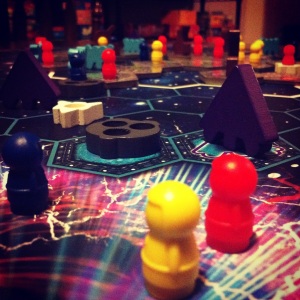 o do on their turn
o do on their turn
In addition to all of the usual classic Survive! actions:
- pawns run screaming towards their near certain deaths
- flip a tile to (a) push opponent pawns into the briny deep, and (b) reveal more stuff (boats, creatures, etc.)
- roll the die and move the sea creatures to hasten the aforementioned deaths
...Survive: Space Attack adds two new things for players to do:
- relocate aliens (because it’s just not fair to keep them captured when all they want to do is hurt your opponents)
- mutate aliens AFTER you roll the movement die (because a little foreknowledge is a dangerous thing)
More choices injects a bit more control into what is admittedly a wonderfully chaotic game system.
Step 6: Add a new mix of space station tiles
The Stronghold Games version of Survive! Escape from Atlantis has 3 different kinds of tiles:
- play immediately (green)
- play at the beginning of your turn (red)
- play defensively (red with an X)
Survive: Space Attack expands the variety of the tile set with four different kinds of tiles:
- play immediately (green) - aliens, fighters, & escape pods
- play during movement (red) - special powers affecting movement and other players
- play after rolling alien movement… but before moving the alien (blue) - mutating powers
- play defensively (yellow) - ways to escape (ominous chord) “certain death!”
Correctly playing the tiles you find is an important part of the path to victory. Getting the maximum benefit has to be balanced against the game timer - because what’s left of the space station will vaporize during one of the last four tile flips.
The iconography on the tiles is pretty good - once you’ve got a game under your belt… but that first game was fun, what with us being clueless about the abilities those tiles would give us.
Step 6: Add bonus scoring
So, now it’s important to send your surviving crew members to different jump points (exits). Evidently, there’s some chance that one of the these wormholes leads straight to the Phantom Zone or the planet where the Monolith sent Agent Simmons or a dimension where you’re forced to watch the odd-numbered Star Trek films over & over on an infinite loop - and you wouldn’t want any of your crew to suffer a fate like that. Each jump point with one of your crew members scores a bonus point.
It’s made a difference in our scores in a couple of games - but the real impact of the bonus rule is to keep players from loading up one side of the space station in an attempt to build an “escape road”, which could happen in typical games of Survive!.
Step 7: Call It Survive: Space Attack
Well, duh.
The Verdict
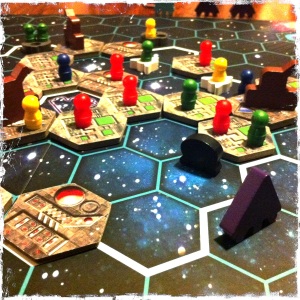 Short Version
Short Version
It rocks.
“The Kids Are Alright” Version
My boys asked for this every night for a week when we first got it - we played our first 5 games in 6 days. They continue to ask for it, even with other new games in the house.
Seriously, who could ask for a better recommendation than that?
Long Version
I’m on record as being a big ol’ Geoff Englestein fanboy. I think his first game, The Ares Project, is woefully underappreciated and both Space Cadets and Space Cadets: Dice Duel are whimsical gaming fun. But this could well be my favorite game from the Family Englestein. (For those who don’t know, Geoff co-designs with his son & daughter.)
As I stated previously, it takes pretty everything that works from the classic Survive game system, strips out the parts that don’t, adds more decisions, and keeps it ripping right along at a family-friendly pace. It works with gamers and non-gamers and has yet to overstay its welcome at the table.
The previous incarnations in this series were less successful with 2 players… but the 2 player variant in the rulebook worked like a charm. In fact, all of the variants we tried worked well - giving a great game more variety and replayability.
There are two expansions coming out for Survive: Space Attack - a 5-6 player set of extra pawns and a deck of crew cards with special powers. I’m willing to bet my boys make sure they’re in my Christmas stocking. (Note: they didn't. Guess I'll have to buy them myself.)
This post originally appeared on the Opinionated Gamers website...




